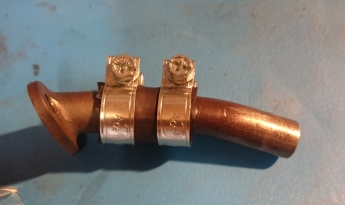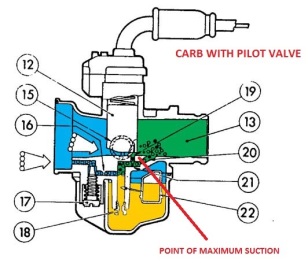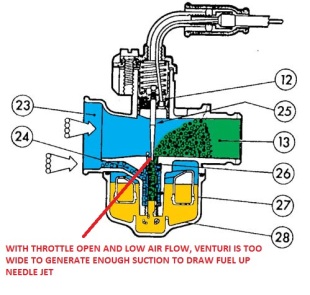and a few other things as well.
First, there’s the engine de-coke and re-build. Whilst doing this, I opened the exhaust port a little and opened the exhaust port throat a little more, smoothing the flow as best I could. A new crankshaft seal was fitted on the drive side and I took particular care to seal the small gap above the key way slot, in the primary drive sprocket, as some primary compression can be lost here. The little end bush also seemed a little tight, so the bush was gently eased using 1500 grade wet and dry sandpaper.
Second, I’ve flexibly mounted the carburetor. Now I was quite nervous about cutting the inlet manifold as there’s no going back but I did it anyway and fortunately, it worked out quite well.

The advantages I hope to gain are:
- Reduced vibration of the carb that could be causing the float to bounce and flood with petrol; a persistent problem I’ve had,
- Reduced heat transfer to the carb from the engine, that I suspect is causing vapour locking , NB: Petrol boils at 95C, however ethanol boils at 78C, so modern fuel are far more prone to this. Sir Walter has always been a bad starter, 10 and 20 minutes after a hot stop.
- Increased clearance between the carb and the wheel as the petrol connector nut can touch the wheel, particularly if the wheel bearings are set a little loose. I cut 6mm out of the manifold and left a 3mm gap between the ends.
The finished job looks quite neat, as shown. You’ll see I changed to a different rubber hose as the black one above was too tight. I just hope the clear reinforced hose I used is ethanol proof, or I’ve a breakdown waiting to happen. I’ve also added some thick black foam rubber around the inlet spigot, so that it’s supported where it goes through the carburetor cover.
Third, I’ve lapped the float needle to the petrol connector using a new method. Previously I’ve spun the needle in a drill whilst holding the petrol connector between my thumb and finger. The problem with this method is the lapped seat may not be axially aligned as it’s done outside the carburetor body. Consequently, it may leak when assembled.
First step is to make a nylon plug on a lathe, that’s a tight slide fit into the float bowl. Also drill a 1.6mm hole in the centre of the plug (on the lathe) to take the float needle, thereby ensuring the 2 diameters are perfectly concentric.
Then fit the petrol connector into the base of the float chamber with its fibre washer and tighten. Next put a dab of fine abrasive paste (Solvol Autosol) on the needle seat and insert it into connector and up through the nylon plug. Finally carefully tighten the chuck of a battery drill onto the exposed tip of the needle and spin it slowly for a minute or so.

Repeat this, cleaning the needle each time, until a good even seat can be seen on the needle. The beauty of this method is that the new seat is perfectly aligned and shouldn’t (I hope) leak.
Fourth, open up the silencer to improve gas flow. This also makes it louder and it’s a scientific fact that something loud goes faster; or so it seems. My silencer is the type that doesn’t come apart (for cleaning), so I simply drilled a 10mm hole in the baffle plate that I could see inside the tailpipe. Yes, crude but effective.
So what’s this got to do with Bernoulli? Well in 1738 Daniel Bernoulli published a book called “Hydrodynamica” (great title), in which he detailed some principles of fluid dynamics.
In a nut shell, he stated that, “if a fluid (liquid or gas) increases its speed, then the pressure drops” and this is one of the fundamental reasons that a 2 stroke engine works. As the products of combustion accelerate down the exhaust port, they cause a drop in pressure that sucks the fresh fuel charge into the cylinder. So it follows that the faster the gases exhaust, the lower the pressure, the greater the suck, the more fuel is drawn in and the more power you get – simple. And that’s what I’ve done to improve Sir Walter, (amongst other things) and IT WORKS!
He can now climb steeper hills without LPA, he’s revving out much, much better and he even sounds fast.
PS, Bernoulli’s principle is why aeroplane wings generate lift, a spinning football bends, ships can’t pass close at sea, jetties always have water beneath them and why a F1 car’s areopackage works, amongst many other things. Where would we be without Hydrodynamica?








